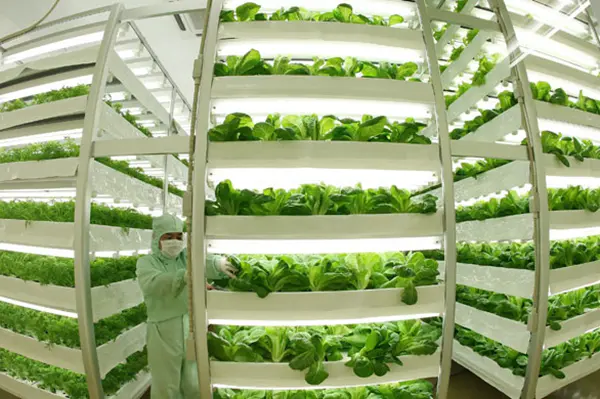No pesticides, no fertilizers and no soil -- the mass-cultivation of plants using hydroponic systems is being heralded by many as the future of agriculture in China.
A scaled-down version of such a "plant factory" was one of the most popular exhibits at an expo on the country's major technological achievements over the past five years, which was held in Beijing earlier this month.
The 130-square-foot greenhouse housed a variety of vegetables neatly arranged on shelves containing water and nutrient solutions, beneath mouthed red and blue LED lighting, technician Yan Wenkai, from the Chinese Academy of Agricultural Sciences, explained.
Beijing citizen Liu Yuping was inspired by the installation, she envisaged a similar, albeit mini, version of the greenhouse on her balcony at home.
"Not only does it looks beautiful, but it produces safe vegetables, I need not worry about pesticides, because the technician told me there won't be any pests," Liu said.
At nearly 10,000 yuan (1,520 U.S. dollars) per 10 square feet, however, there is unlikely to be a "vegetable rush," just yet.
Smart Planting
China is one of the few countries in the world to build large-scale "plant factories." Scores are scattered across the country, managed by research institutes and agricultural firms.
Huang Qingman, a plant factory technician with a project run by the provincial academy of agricultural sciences in east China's Fujian Province, said that technology has made it possible to grow plants almost anywhere.
"Just like some babies are fed formula milk, we feed our crops with a solution enriched with 16 different nutrients," Huang told Xinhua.
The temperature, humidity, lighting and carbon dioxide level in the farm, as well as supplies of water and nutrients, are all carefully controlled, Huang said.
Compared with traditional farming, plant factories are more efficient in terms of space and labor, resulting in increased yields that are not at risks from water, soil or pesticides contamination.
In Huang's farm, two workers can manage a 36,000-square-feet greenhouse. Moreover, factory-produced crops are ready for harvest in as little as 15 days.
A 7,000-square-feet greenhouse can yield up to 60 tonnes of vegetables a year, compared with the annual output of around 11 tonnes from a traditional farm of the same size.
Jobs in a plant factory are more attractive than labor on traditional farms, said Zheng Huiyong, director of the Institute of Digital Agriculture under Fujian Academy of Agricultural Sciences. "Here, young rural dwellers have college degrees. They wear leather shoes and don't have to bend down."
Far From Home
While there is no doubt that the new system will change the landscape of the sector, commercialization is no easy task, mainly due to the high financial outlay.
Chen Xianqiu, with the agricultural department of south China's Guangdong Province, said he was excited by factory-based farming, which saves land and is immune from droughts, floods and pests.
In addition, the potential consumer market is huge, as currently the per capita vegetable consumption of Chinese is only 40 percent that of their European counterparts.
"Let's assume that our consumption increases to the European level, and 30 percent of the additional vegetables are produced in factories, that would be a market worth hundreds of billions of yuan," said Gui Shirong, who manages a plant factory in Foshan City, Guangdong.
Greenhouse construction and maintenance, as well as tech-intensive management have a downside -- 500 grams of factory vegetables will cost 20 yuan, which is more expensive than organic vegetables.
Gui said as time goes on, the costs will decline, as factory-based crops are largely still in the research stage.
Currently, his farm has chosen to grow produce with higher economic value, such as asparagus, for hotels and high-end supermarkets, and plans to plant fruit and traditional Chinese medicine ingredients in the future. Private greenhouses have been established in two high-end communities in Shenzhen city of Guangdong.
Yan Wenkai said the Chinese Academy of Agricultural Sciences had helped to build plant factories for the military in regions unsuitable for certain vegetables, such as Xinjiang and Tibet.
"We hope such factories can use abandoned workshops and underground space, as well as wasteland and desert. Who knows? In the future maybe even on moon or other planets," Yan said.
(APD)
 简体中文
简体中文

